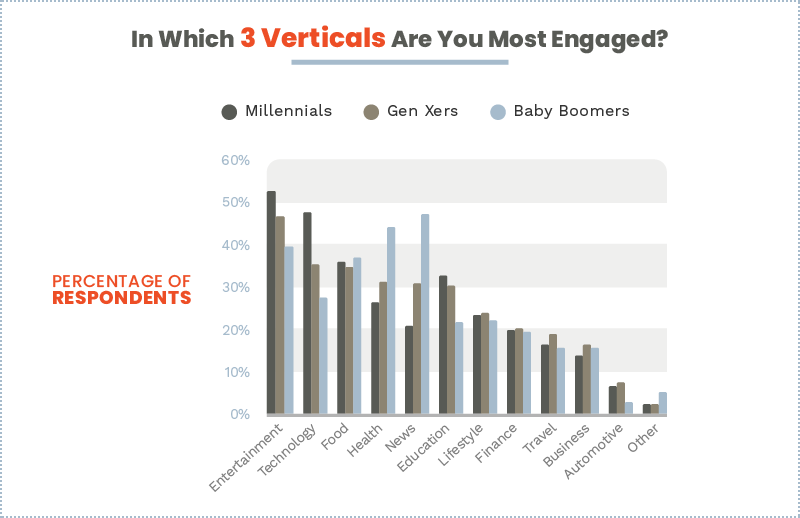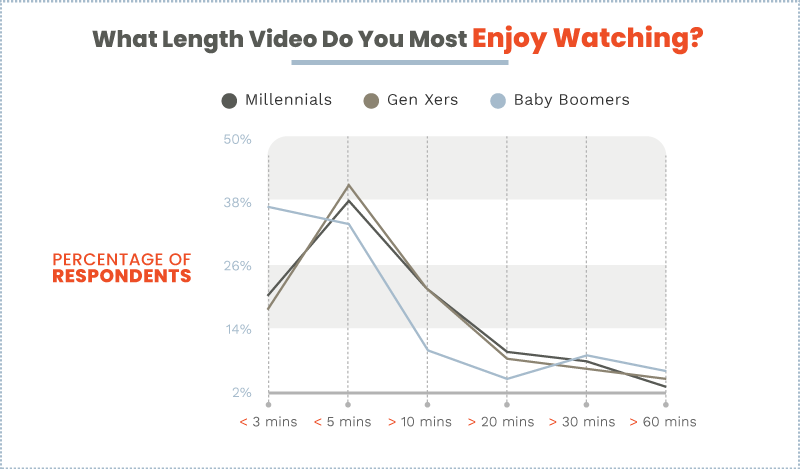Understanding the key differences among generational groups isn’t rocket science. But when it comes to your content, marketing to the generations can make you feel like a freshman in a theoretical physics class full of Sheldons.
Don’t worry – we got you.
We previously surveyed 1,200 people from three different generations (Millennials, Gen Xers, and Baby Boomers) about the types of content they consume and when they consume it.
Whether you’re focusing on one generation or your target audience spans several, the takeaways below will help you plan your content lineup accordingly.
1. Plan for which vertical to target before you create content.
Knowing which vertical or niche you’ll pitch your content to will increase the likelihood of it getting covered.
Why?
Because if you conduct a study or perform original research (survey, experiment, interview, etc.) that’s focused on a specific vertical or publisher’s audience, those writers/editors will be eager to dive into it.
Looking to increase brand awareness? While the constraints of your brand might make it seem like your content should only fall under one vertical, tangential content that’s loosely related to your product or service is the way to go. This also allows you to target a specific generation based on vertical.
We asked our survey respondents the top 3 verticals they engage with the most. The findings are important because the publishers who would be interested in your content will likely belong to one of these.
PRO TIP: Research specific writers and/or editors to find ones who write about the niche your content is focused on. Also, tailor your pitch so it matches their writing style and make a personal connection with them. This tells them you’ve done your research and are not spamming anyone and everyone.
Now, let’s go through the survey’s results from the graph above and see what publishers could be good to target. (Note: Some of the publishers listed may fit several verticals.)
Verticals by Generation
Millennials (born 1977–1995) are slightly more engaged than both Gen Xers and Baby Boomers in three verticals: entertainment, technology, and education.
Baby Boomers (born 1946–1964) read and seek out content in the health and news verticals significantly more than any other generation.
Gen Xers (born 1965–1976) are involved in five verticals more than any other generation – lifestyle, finance, travel, business, and automotive – although their lead is only a sliver more in a few instances.
Unless you’re in the automotive industry, you may want to avoid creating content hyper-focused on automobiles; less than 10 percent of each generation engages in the automotive vertical.
Once you’ve nailed down the vertical for your marketing generation content, it’s time to choose your content format and create your content. If you’re thinking of video, check out this next takeaway.
2. Keep videos short, especially for Baby Boomers.
Our previously reported findings from the survey noted that 300 words is the sweet spot among all generations for the length of online articles. So how do the length of videos compare? If you’re aiming to appeal to viewers of all ages with your video, cap it at 5 minutes.
Over 70 percent of Baby Boomers prefer videos to be 5 minutes or less, with about 37 percent losing interest after 3 minutes. About 60 percent of both Millennials and Gen Xers have 5-minute limit for videos as well.
Over 20 percent of both Millennials and Gen Xers prefer a video longer than 10 minutes, compared with only 10 percent of Baby Boomers.
Next, let’s look at what the different generations say the most important parts of a piece of content are.
3. Spend time on your title/headline.
While you don’t usually have control over the headline a journalist uses in their story when covering your content, the title of your content or headline of your article/blog post can influence the direction they take – headline included.
How influential is a headline? More than 78 percent of all generations said the headline was one of the most important factors in determining whether or not they wanted to read an article.
Sometimes reporters use the subject lines we use in our email pitches as the headline of their articles, so be sure to give yours plenty of thought.
PRO TIP: As revealed in our Tell-All Guide to Digital PR, which includes the exclusive results from our survey of 1,300 publishers, your subject line will be most effective when it’s 45–64 characters and a max of 10 words.
Our ebook also goes into detail about the types of subject lines that perform best based on the vertical/industry. Here’s a snippet:
In addition to the headline, all three generations also agreed the article topic and a dominant image were important factors.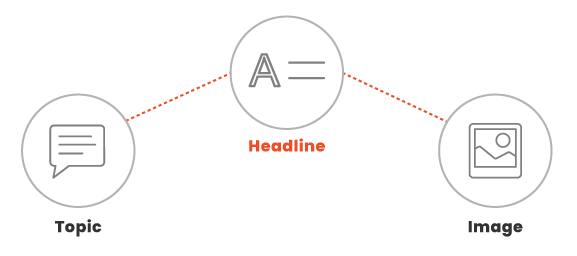
Before we show you when the generations consume content the most, let’s look at one last finding from our survey that involves the sentiment of your content.
4. Focus on the positive in your content.
While negative news often gets the most attention (presidential concerns, anyone?), your audience may not be seeking it.
Similar to the findings from our research on viral emotions, the respondents to our marketing to the generations survey showed preference to reading good news over more depressing stories.
Specifically, over 60 percent of each generation believe words such as “amazement,” “admiration,” and “joy” describe how they feel most often for the majority of the content they consume.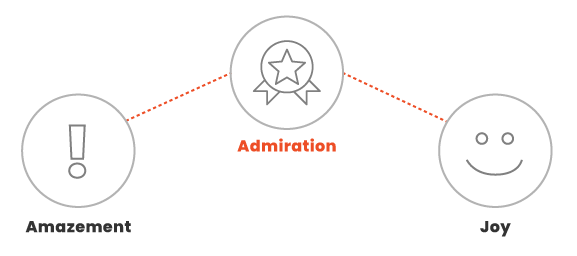
PRO TIP: Based on our survey results, you should create content that elicits feelings of “surprise” and “amazement” if you’re targeting Baby Boomers and/or Millennials. Aim for “admiration” and “trust” if your market is Gen Xers.
Finally, let’s review the best timing for your content to be seen by the different generations.
5. For Millennials to notice, plan for the weekend.
While 35 percent of both Millennial and Gen X generations consume online content between 8 p.m. and midnight, Millennials take the lead for perusing the internet on the weekends.
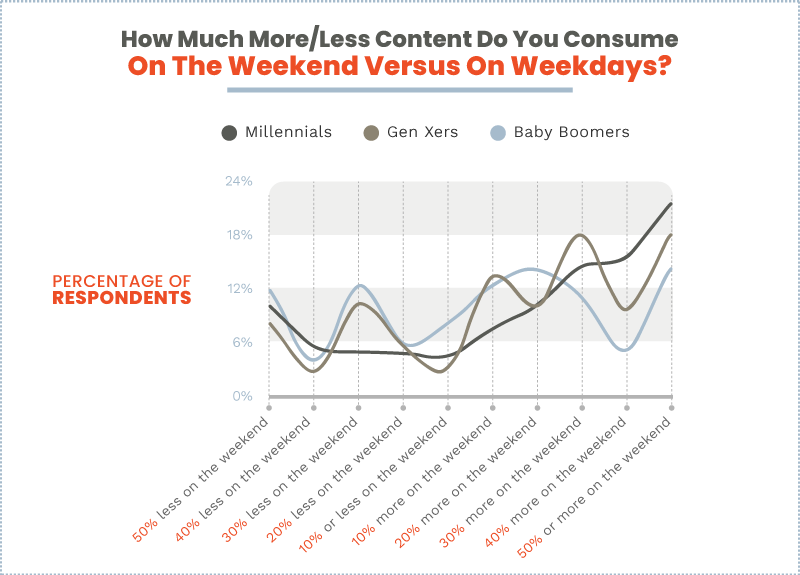
Looking at the data another way: About 12 percent of Baby Boomers consume 30 percent less content on the weekend, compared with just 5 percent of Millennials.
Gen Xers are more of a mixed bag, with this generation generally leaning toward the weekend versus weekdays.
PRO TIP: When marketing to the generations, tell the writers who ask what your preference is regarding when they publish their coverage of your content.
Planning Your Marketing to the Generations
All of the takeaways we discussed above are easiest to implement when you create a roadmap of your content and promotions strategy ahead of time. It’d be quite difficult to change the vertical you pitch it to after the content is finalized!
While the generational differences in consuming content do exist, your main focus should still be on creating high-quality content and a solid outreach plan.
Have you had success with certain generational marketing tactics? If so, we’d love to hear about it in the comments below!

